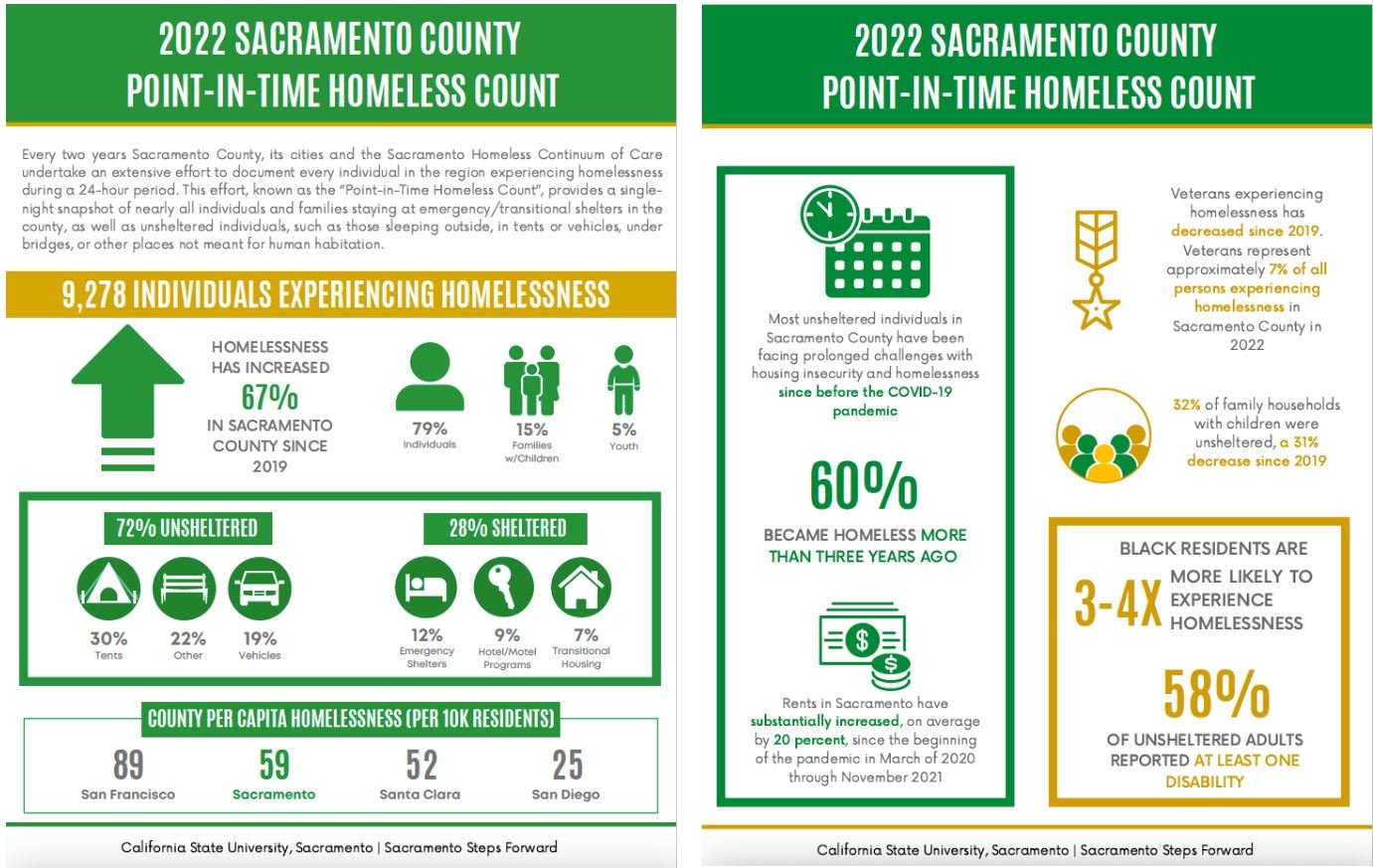Higher numbers but some glimmers of hope in Sacramento homeless Point-in-Time Count
Sacramento (June 28, 2022) Consistent with statewide trends, the number of people living unsheltered in Sacramento has risen sharply in the three years since the last official Point-in-Time Count.
The PIT Count, conducted by more than 500 volunteers over two nights in late February, found 9,278 people living without homes in Sacramento County. That’s up 67 percent from the last PIT Count, conducted in 2019. This year’s count found 92 percent of those surveyed were from Sacramento, and most of them, 72 percent, were unsheltered, meaning they slept on the ground, in a tent or in a vehicle.
Approximately three quarters of the people found in all of Sacramento County on those two nights were located within the Sacramento City Limits.
Interior of the City’s Meadowview Navigation Center for women
Sacramento city and county have boosted their efforts to shelter and serve those experiencing homelessness, and there are signs that those efforts can succeed. The City now operates 1,050 safe spaces, beds, tiny homes and motel rooms each night, a tenfold increase since 2017. The new Department of Community Response works daily to provide those experiencing homelessness with resources and housing options.
Unsheltered homelessness among families with children dropped by 31 percent over the three-year period – a decrease researchers at Sacramento State University who compiled the report attributed in part to the City’s leasing of hundreds of motel rooms to provide temporary shelter.
“There are fewer families with children living on the streets, at least partially because of our City motel voucher program,” said Bridgette Dean, director of the City’s Department of Community Response. “We have seen the success and immediate impact of having dedicated motels as shelter options for those most at risk, in lieu of housing options.”
The City of Sacramento has five motels under contract with 370 rooms housing approximately 450 people. Most of the rooms are dedicated to families with children.
The number of homeless veterans dropped by 6 percent.
While more families and veterans came indoors, the number of chronically homeless people more than doubled. Fifty eight percent of those interviewed said they struggled with one or more disabling medical conditions such as mental health issues or addiction.
Black people have been disproportionately affected by homelessness, comprising 31 percent of the unhoused county-wide, but only 11 percent of the population.
The City’s Grove cabin community for transition-aged youth
Mayor Darrell Steinberg said the results of the count point to the need for more mental health and substance abuse treatment efforts targeting the unhoused population. He noted that the City of Sacramento stands ready to work with county and state partners in standing up the resources commensurate with the need to effectively help the chronically homeless population and reduce the most visible and problematic impacts of unsheltered homelessness on the community.
Mayor Steinberg supports Governor Newsom’s Care Courts proposal, which would require counties to provide mental health services to people experiencing homelessness, and which would require them to take them.
“The City will continue to do our part wherever we can, which is to create Safe Grounds, respite, shelters, motels and navigation services wherever we can, but that’s not enough,” Mayor Steinberg said. “We need more help on the mental health and substance abuse side. The City is not a health and human services agency. That’s not what we do.”
Sacramento’s per capita rate of homelessness remains far lower than San Francisco’s – 59 per 10,000 people compared to 89 in San Francisco – and is about the same as Alameda’s, researchers found.
Researchers consider high housing prices a major driver of homelessness. Chronically homeless participants surveyed during the Point-in-Time Count cited more affordable housing as the most important thing that could be done to help them.
A recent influx of households with higher incomes moving from the Bay Area has put pressure on the local housing market. Regionally, over the last year, median household income increased by twelve percent, far outpacing the typical three percent average and it is estimated that these increases are primarily resulting from new residents, making the housing market more competitive than ever.
The City of Sacramento has substantially boosted production of affordable housing in the past five years from 481 units a year in 2018 to more than 2,000 today. There are 644 affordable units either under construction or breaking ground in the city in the next month. The City also obtained funding through the state’s Homekey program to convert three motels into permanent supportive housing for people experiencing homelessness. In addition, the Capitol Park Hotel downtown is also in the process of being converted to permanent supportive housing.
The Point-in-Time Count is conducted by Sacramento Steps Forward, the non-profit agency that coordinates community-wide efforts to reduce homelessness.






